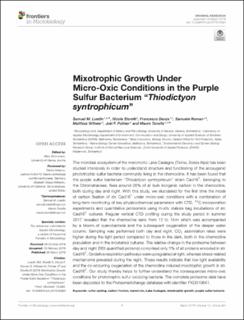Please use this identifier to cite or link to this item:
https://doi.org/10.21256/zhaw-4784Full metadata record
| DC Field | Value | Language |
|---|---|---|
| dc.contributor.author | Luedin, Samuel M. | - |
| dc.contributor.author | Storelli, Nicola | - |
| dc.contributor.author | Danza, Francesco | - |
| dc.contributor.author | Roman, Samuele | - |
| dc.contributor.author | Wittwer, Matthias | - |
| dc.contributor.author | Pothier, Joël F. | - |
| dc.contributor.author | Tonolla, Mauro | - |
| dc.date.accessioned | 2019-03-07T13:34:27Z | - |
| dc.date.available | 2019-03-07T13:34:27Z | - |
| dc.date.issued | 2019-03-05 | - |
| dc.identifier.issn | 1664-302X | de_CH |
| dc.identifier.uri | https://digitalcollection.zhaw.ch/handle/11475/15864 | - |
| dc.description.abstract | The microbial ecosystem of the meromictic Lake Cadagno (Ticino, Swiss Alps) has been studied intensively in order to understand structure and functioning of the anoxygenic phototrophic sulfur bacteria community living in the chemocline. It has been found that the purple sulfur bacterium “Thiodictyon syntrophicum” strain Cad16T, belonging to the Chromatiaceae, fixes around 26% of all bulk inorganic carbon in the chemocline, both during day and night. With this study, we elucidated for the first time the mode of carbon fixation of str. Cad16T under micro-oxic conditions with a combination of long-term monitoring of key physicochemical parameters with CTD, 14C-incorporation experiments and quantitative proteomics using in-situ dialysis bag incubations of str. Cad16T cultures. Regular vertical CTD profiling during the study period in summer 2017 revealed that the chemocline sank from 12 to 14 m which was accompanied by a bloom of cyanobacteria and the subsequent oxygenation of the deeper water column. Sampling was performed both day and night. CO2 assimilation rates were higher during the light period compared to those in the dark, both in the chemocline population and in the incubated cultures. The relative change in the proteome between day and night (663 quantified proteins) comprised only 1% of all proteins encoded in str. Cad16T. Oxidative respiration pathways were upregulated at light, whereas stress-related mechanisms prevailed during the night. These results indicate that low light availability and the co-occurring oxygenation of the chemocline induced mixotrophic growth in str. Cad16T. Our study thereby helps to further understand the consequences micro-oxic conditions for phototrophic sulfur oxidizing bacteria. The complete proteome data have been deposited to the ProteomeXchange database with identifier PXD010641. | de_CH |
| dc.language.iso | en | de_CH |
| dc.publisher | Frontiers Research Foundation | de_CH |
| dc.relation.ispartof | Frontiers in Microbiology | de_CH |
| dc.rights | https://creativecommons.org/licenses/by/4.0/ | de_CH |
| dc.subject | Aquatic microbiology | de_CH |
| dc.subject | Microbial sulfur metabolism | de_CH |
| dc.subject.ddc | 570: Biologie | de_CH |
| dc.title | Mixotrophic growth under micro-oxic conditions in the purple sulfur bacterium "Thiodictyon syntrophicum" | de_CH |
| dc.type | Beitrag in wissenschaftlicher Zeitschrift | de_CH |
| dcterms.type | Text | de_CH |
| zhaw.departement | Life Sciences und Facility Management | de_CH |
| zhaw.organisationalunit | Institut für Umwelt und Natürliche Ressourcen (IUNR) | de_CH |
| dc.identifier.doi | 10.21256/zhaw-4784 | - |
| dc.identifier.doi | 10.3389/fmicb.2019.00384 | de_CH |
| zhaw.funding.eu | No | de_CH |
| zhaw.issue | 384 | de_CH |
| zhaw.originated.zhaw | Yes | de_CH |
| zhaw.publication.status | publishedVersion | de_CH |
| zhaw.volume | 10 | de_CH |
| zhaw.publication.review | Open peer review | de_CH |
| zhaw.webfeed | Umweltgenomik | de_CH |
| zhaw.funding.zhaw | High-throughput proteomics of Thiodictyon synthrophicum strain Cad16T | de_CH |
| Appears in collections: | Publikationen Life Sciences und Facility Management | |
Files in This Item:
| File | Description | Size | Format | |
|---|---|---|---|---|
| Luedin2019b.pdf | 2.91 MB | Adobe PDF |  View/Open |
Show simple item record
Luedin, S. M., Storelli, N., Danza, F., Roman, S., Wittwer, M., Pothier, J. F., & Tonolla, M. (2019). Mixotrophic growth under micro-oxic conditions in the purple sulfur bacterium “Thiodictyon syntrophicum”. Frontiers in Microbiology, 10(384). https://doi.org/10.21256/zhaw-4784
Luedin, S.M. et al. (2019) ‘Mixotrophic growth under micro-oxic conditions in the purple sulfur bacterium ‘Thiodictyon syntrophicum’’, Frontiers in Microbiology, 10(384). Available at: https://doi.org/10.21256/zhaw-4784.
S. M. Luedin et al., “Mixotrophic growth under micro-oxic conditions in the purple sulfur bacterium “Thiodictyon syntrophicum”,” Frontiers in Microbiology, vol. 10, no. 384, Mar. 2019, doi: 10.21256/zhaw-4784.
LUEDIN, Samuel M., Nicola STORELLI, Francesco DANZA, Samuele ROMAN, Matthias WITTWER, Joël F. POTHIER und Mauro TONOLLA, 2019. Mixotrophic growth under micro-oxic conditions in the purple sulfur bacterium „Thiodictyon syntrophicum“. Frontiers in Microbiology. 5 März 2019. Bd. 10, Nr. 384. DOI 10.21256/zhaw-4784
Luedin, Samuel M., Nicola Storelli, Francesco Danza, Samuele Roman, Matthias Wittwer, Joël F. Pothier, and Mauro Tonolla. 2019. “Mixotrophic Growth under Micro-Oxic Conditions in the Purple Sulfur Bacterium “Thiodictyon Syntrophicum”.” Frontiers in Microbiology 10 (384). https://doi.org/10.21256/zhaw-4784.
Luedin, Samuel M., et al. “Mixotrophic Growth under Micro-Oxic Conditions in the Purple Sulfur Bacterium “Thiodictyon Syntrophicum”.” Frontiers in Microbiology, vol. 10, no. 384, Mar. 2019, https://doi.org/10.21256/zhaw-4784.
Items in DSpace are protected by copyright, with all rights reserved, unless otherwise indicated.